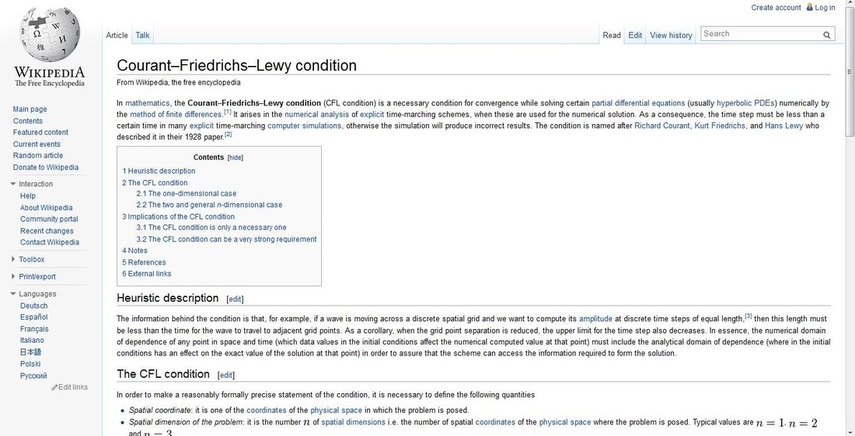CFL Condition
It is known that the Courant number depends on velocity, cell-size and time step and is typically calculated for each cell (will add some visual examples). The Courant number will accordingly change a bit with velocity when you have a static mesh and a constant time step. Now, assuming here that your mesh is static (non-moving ‘such as for a turbine blade’/morphing ‘deforming particle such as a water droplet’) and that the velocity field is more or less fully developed, changing the time step is a good way of controlling the Courant number.
A physical explanation, for a CFD simulation, of the Courant number could be that it tells you something about how fluid is moving through your computational cells. Meaning that If the Courant number is <=1 then the fluid particles move from one cell to another within one time step (at most). While if the Courant number is >1 a fluid particles moves through two or more cells at each time step and this can affect convergence negatively.
A physical explanation, for a CFD simulation, of the Courant number could be that it tells you something about how fluid is moving through your computational cells. Meaning that If the Courant number is <=1 then the fluid particles move from one cell to another within one time step (at most). While if the Courant number is >1 a fluid particles moves through two or more cells at each time step and this can affect convergence negatively.
Kolmogorov Microscales
Kolmogorov microscales are the smallest scales in turbulent flow. At the Kolmogorov scale, viscosity dominates and the turbulent kinetic energy is dissipated into heat. More info available in the following Link.
Why is the CFL Condition Important
This is a question that always worries engineers more than mathematicians or applied physicists. I will say why later once I coves the following point:
1- How can I find the right value of the CFL condition why would I care if its 5 or 10 or a 100000. Once you run your numerical simulation you will require to validate the data with experimental. That is when you need play around with the different input parameters to assure that you can get the closest set of data that mimics the real life condition. Having a result of the researcher having confidence of the selected input values.
2- The CFL condition is a value that can assure that you are solving the differential equations (using approximation methods) with the right input parameters.
Therefore mathematicians and applied physicists come across the CFL condition through studying computational PDEs modules or Quantum physics modules while during undergrad engineering modules no emphasis is given that much to such issues.
Examples
1-If your flow modelling in porous media then it is required from you to select low courant numbers <=1, becouse it will take the air partciles some time in order to diffusie through the soil cavaties.
2-I presume for now not sure yet but it is required to chose small courant numbers also for combustion modelling of multi species combsution processes, becouse at each cell chemical reactions happen in a fast rate.
3-I presume for now for sonic, supersonic flows than you need to run high courant numbers becouse the extent of particales flowing through cells is so high, not sure about its impact on the formed shock waves.
2-I presume for now not sure yet but it is required to chose small courant numbers also for combustion modelling of multi species combsution processes, becouse at each cell chemical reactions happen in a fast rate.
3-I presume for now for sonic, supersonic flows than you need to run high courant numbers becouse the extent of particales flowing through cells is so high, not sure about its impact on the formed shock waves.
With large Courant numbers way into the hundreds, but it's a good place to look if you have Convergence problems and it also can affect accuracy of a transient simulation. Diffusion dominated problems should typically be run with low Courant numbers, if lower time step to lower Courant number, raise time step to increase Courant number.
At one point you will need to understand the CFL condition and the steps in runing simulations with different CFL values.
Unless otherwise noted, all content on this site is @Copyright by Ahmed Al Makky 2012-2013 - http://cfd2012.com
